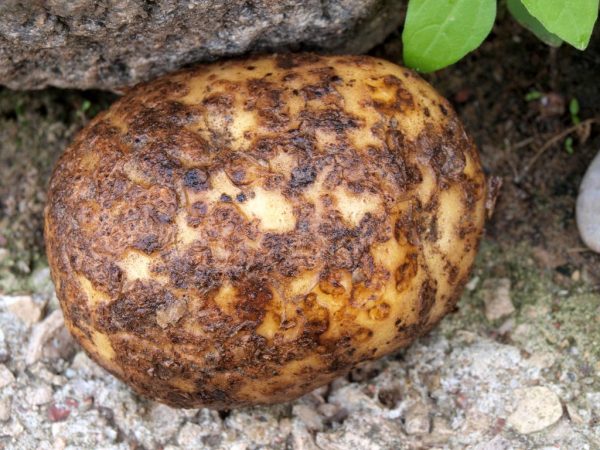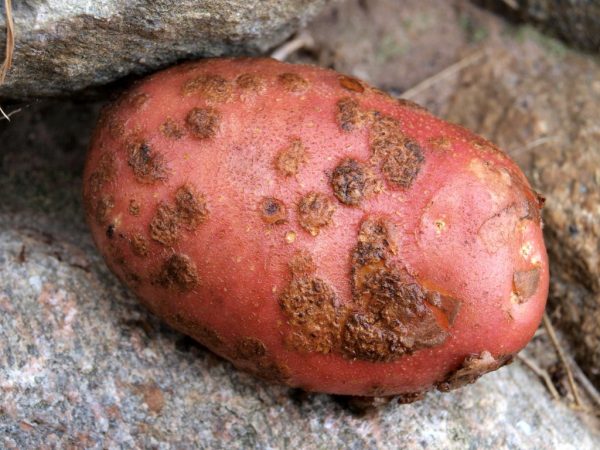Definition and treatment of potato cancer
When growing vegetables, gardeners are often faced with the need to protect plants from pests and diseases. If potato growers can fight insects quite successfully, then plant treatment requires more attention. A dangerous disease of nightshade crops is potato cancer. Most often, it appears in personal plots, where potatoes are planted every year as the main food product. To avoid the appearance of potato cancer, you need to know its features, and how to deal with it.

Definition and treatment of potato cancer
What is potato cancer
This disease spreads throughout the plant and is caused by spores of the fungus Synchytrium endobioticum. Hibernating in the soil, dormant spores tolerate frost well. Zoosporangia is covered with a 3-layer membrane. This allows the pathogen to remain viable for many years until a favorable time for spore germination comes.
Most of them are capable of germination in spring. A zoosporangia colony consists of 200 or 300 flagellate spores that can move in the soil and invade potato cells. The remaining dormant sporangia can germinate and infect plants even after 30 years. Therefore, potato cancer is considered a quarantine disease in many potato growing countries.
Distinctive features of the disease can be considered the reaction of spores to temperature changes. Severe frosts, in which the soil freezes to a great depth, destroy the causative agent of cancer. A temperature of -11 ° C at a depth of 20cm for several weeks can kill zoospores. High summer temperatures, around 30 ° C, are also detrimental to the fungus.
Causes of the disease
The causative agent of potato cancer is a pathogenic fungus that invades the soft tissues of a young plant. Cancer mainly affects potato plantations and can destroy the entire crop. The most favorable conditions for the development of the disease are high humidity and soil temperatures within 18 ° C. Flagellate zoospores move along soil capillaries for 12 hours. If during this time they do not penetrate into the plant, then they dry out and die.
Zoosporangia can get to the site in several ways.
- When planting spore-infested tubers.
- When healthy planting material carries soil particles in which the fungus is located.
- When working with an infected tool, you can also bring the virus to the site.
- Spores can enter the soil if they are brought in by animals or people who have been in the contaminated area and have not treated shoes.
If gardeners, upon visual inspection of the tubers, find damage, then it is better to abandon planting them so as not to cause irreparable harm to their plants.
It happens that the fungus enters along with the seedlings or seedlings that were grown in the infected area. Lumps of dirt that remain on tools such as shovels, hoes and rakes can be dangerous if used on contaminated soils.
When feeding pets with sick tubers that have not been heat treated, spores can get into the soil with manure because they do not die in the digestive tract. During spring floods, melt water easily transfers soil particles from higher areas to lowlands, also contributing to the spread of pathogenic fungi.
Symptoms of the disease
Getting into the cells of the plant, the fungus begins its life cycle, it intensively divides and forms growths. In their center, new spores develop, which mature for about 14 days. More than 17 generations of the parasitic fungus can mature during the season. Its presence is easily detected on tops and leaves. If these parts are affected, they show small growths that look like cauliflower. They are green because the parasitic spores do not interfere with the formation of chlorophyll. Flower brushes turn into a loose lump, among which you can see the intergrown and ugly curved flowers.
Tubers affected by the fungus are found only at harvest.
Young potatoes bear dotted whitish tubercles in the area of the eyes and determine the primary infection from them. Under the influence of toxins, cells adjacent to the tubercles begin to divide intensively, turning into huge growths. They are even larger than the tubers themselves.

Disease can kill an entire crop
At first, pathogenic formations retain a whitish hue, but then they darken and begin to rot.
Varieties of potato cancer
- The main type is cancers, of a loose structure.
- There are leaf-like growths, similar to a flattened pine cone.
- Wrinkled nodules and depressions with wavy edges are characteristic of the corrugated form of the disease.
- With a scab-like form of the disease, you can see small lesions in the form of plaques, typical of scab.
Each type of growth bursts when ripe and spreads around millions of spores. Even the initial presence of several sporangia in 1 g of soil can destroy up to 60% of the crop because the fungus multiplies rapidly, especially if you do not fight the disease in time, do not take measures to stop the spread of the pathogen throughout the site.
Treatment
The main thing in the fight against fungal spores is to prevent the disease. To protect your site from sporangia:
- you need to plant potatoes no more than 1 time in 4 years in the same place;
- other nightshade crops should not be planted nearby;
- it is necessary to destroy all weeds, especially nightshade;
- you cannot purchase planting material from quarantine zones;
- if there are a number of quarantine areas, you need to start growing varieties that are resistant to potato cancer.
By adhering to such rules, it is possible to ensure that the access of the pathogenic fungus to the site is prevented.
But if an infection suddenly occurred, then it is necessary to fight the disease. The first item will be to notify the plant protection inspectorate in order to create a quarantine zone. Scientists from several countries have created Agroatlas. It discusses in detail the description of various plants, methods of working with them. Disease control measures, virus prevention and pest control occupy a special place.
Even if potato cancer does not pose a danger to humans, it is still necessary to remove all contaminated product from cooking. Diseased plants, tubers and root system must be burned or repaired in a hole more than 1.2 m deep. In this case, all parts are sprinkled with bleach, filled with kerosene or formalin.
Prophylaxis
2 or 3 years before planting potatoes, the soil must be cultivated in the infected areas and during this time it is forbidden to cultivate all crops. The work is carried out exclusively by specialists using a 2% solution of Nitrofen. In this case, 20 l of the solution is applied to 1m² of soil.
For disinfection of planting material, a 5% solution of Benomil or Benleit is used, as well as a 1% solution of Fundazol. The tubers are soaked for half an hour and planted. Work must be carried out in protective rubber gloves, an apron and a mask.
Conclusion
If the crop rotation of agricultural crops is observed, preventive work is carried out to prevent infection of the site with potato cancer, you can be sure that a rich harvest will replenish the bins of gardeners. Beautiful and healthy tubers will be a good reward for your attention to plants, for maintaining the fertility of the soil and keeping it in perfect order.


